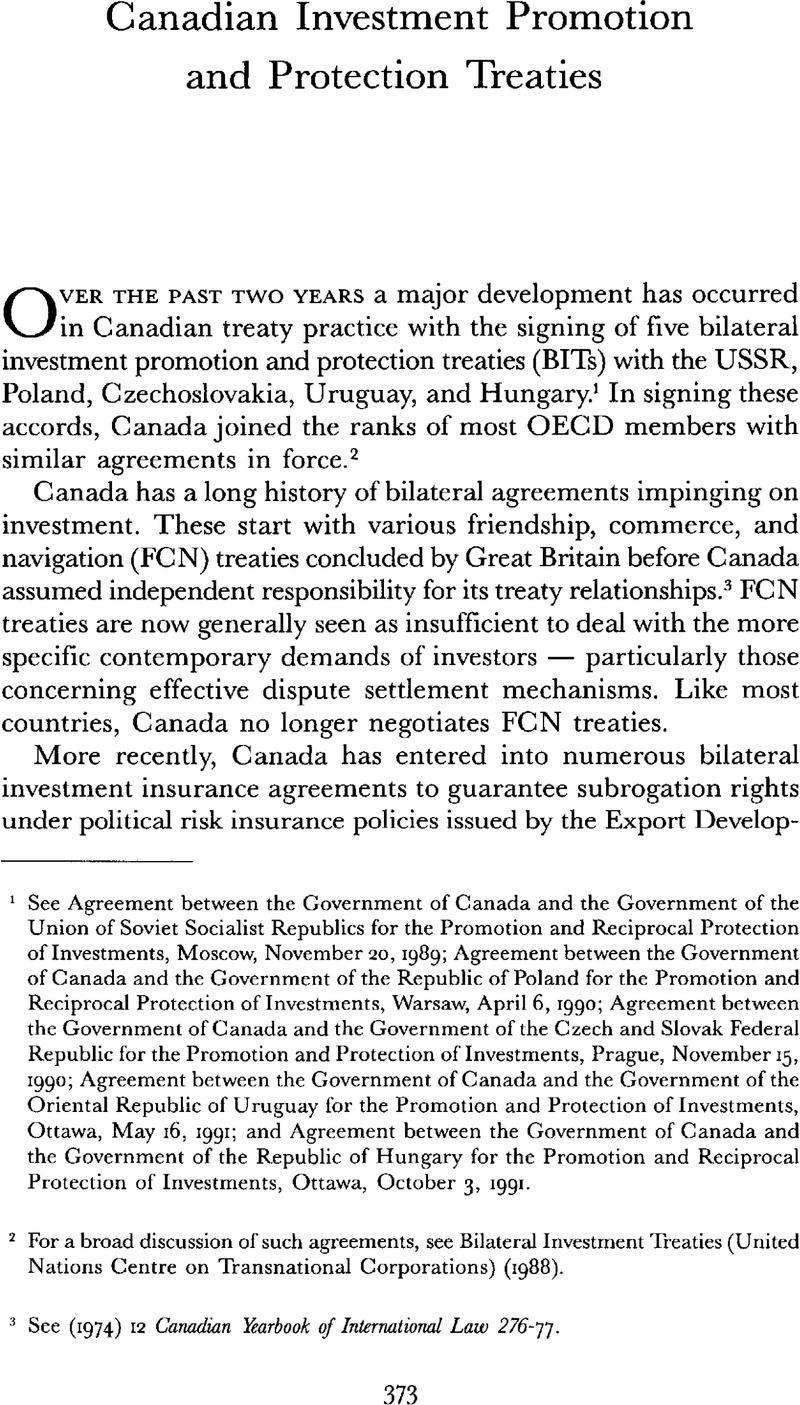Published online by Cambridge University Press: 09 March 2016

1 See Agreement between the Government of Canada and the Government of the Union of Soviet Socialist Republics for the Promotion and Reciprocal Protection of Investments, Moscow, November 20, 1989; Agreement between the Government of Canada and the Government of the Republic of Poland for the Promotion and Reciprocal Protection of Investments, Warsaw, April 6, 1990; Agreement between the Government of Canada and the Government of the Czech and Slovak Federal Republic for the Promotion and Protection of Investments, Prague, November 15, 1990; Agreement between the Government of Canada and the Government of the Oriental Republic of Uruguay for the Promotion and Protection of Investments, Ottawa, May 16, 1991; and Agreement between the Government of Canada and the Government of the Republic of Hungary for the Promotion and Reciprocal Protection of Investments, Ottawa, October 3, 1991.
2 For a broad discussion of such agreements, see Bilateral Investment Treaties (United Nations Centre on Transnational Corporations) (1988).
3 See (1974) 12 Canadian Yearbook of International Law 276–77.
4 For a sourcebook concerning these accords, see Meron, , Investment Insurance in International Law (1976)Google Scholar. Subrogation refers to the insurance law doctrine whereby, in consideration of meeting the insured’s claim, the insurer can recover the value of any benefits available to the insured incidental to the loss. The bilateral investment insurance agreements oblige recognition by host states of EDC’s subrogation rights as an insurer.
5 See Paterson, (ed.), Canadian Regulation of International Trade and Investment 294 (1986).Google Scholar
6 Draft Convention on the Protection of Foreign Property and Resolution of the OECD on the Draft Convention, OECD Paris, 1967.
7 See Voss, , “The Protection and Promotion of Foreign Direct Investment in Developing Countries; Interests, Interdependències, Intricacies,” (1982) 31 Int’l and Comp. L.Q. 686 Google Scholar. For a compilation of all BITs extant, see Investment Laws of the World: Investment Treaties, Vols. 1–3 (ICSID) (1991).
8 Canada’s International Investment Position (1989) (Statistics Canada). The largest host countries were Brazil ($1.5 billion), Indonesia ($0.9 billion), and Mexico ($0.17 billion).
9 For an excellent historical analysis of FIRA, see Franck, and Gudgeon, , “Canada’s Foreign Investment Control Experiment: The Law, the Context and the Practice,” (1975) 50 N.Y.U.L. Rev. 74.Google Scholar
10 See Mo, , “Some Aspects of the Australia-China Investment Protection Treaty,” (1991) 25 J. of World Trade 43.CrossRefGoogle Scholar
11 See Notes for a Speech by the Minister for International Trade to the Canada-U.S.S.R. Business Council, Moscow, October 24,1990. For up-to-date perspectives on investment in Eastern Europe and the USSR, see “Special Symposium Issue: Trade and Foreign Investment in Eastern Europe and the Soviet Union,” (1991) 24 Vanderbilt J. of Transnational Law 205–448.
12 “Joint Ventures Grow Amid Soviet Gloom,” Globe and Mail, Toronto, September 10, 1991.
13 See Financial Post, February 27, 1990, at 6.
14 See Financial Post, August 28, 1989, at 10.
15 See Shea, , The Calvo Clause (1955).Google Scholar
16 Article I of the USSR BIT defines the words “territory,” “investment,” “returns,” and “investor.”
17 Article I(b). This functional definition can be contrasted with that contained in Article 1611 of the Canada-United States Free Trade Agreement, which requires a permanent establishment in the host state.
18 Ibid.
19 See supra note 2, at 22–23.
20 Article 2(3).
21 Ibid.; cf. Canada-United States Free Trade Agreement, Article 1608.1.
22 Article 14 (2).
23 Inquiries of the Department of External Affairs about these variations in the commencement of treaty coverage failed to reveal any explanation of them.
24 Artide 2(2).
25 The inapplicability of Article 24 of the GATT to preferences regarding investment necessitates a specific provision of this kind.
26 See supra note 2, at 70.
27 Article I defines “returns” as “all amounts yielded by an investment and, in particular, though not exclusively, profits, interest, capital gains, dividends, royalties, fees or other current income.”
28 Article 7(3).
29 Article 5(2).
30 For the text of the Convention, see (1965) 4 Int’l Leg. Mat. 524.
31 Ibid., Article 54(1).
32 As adopted by the United Nations Commission on International Trade Law on April 28, 1976 (UN Sales No. E.77.V.6). For the text of the Rules, see Paterson and Thompson (eds.), UNCITRAL Arbitration Model in Canada, Appendix 6 (1987).
33 See Brierley, , “International Trade Arbitration: The Canadian Viewpoint,” in Macdonald, , Morris, , and Johnson, (eds.), Canadian Perspectives on International Law and Organization 826 (1974).CrossRefGoogle Scholar
34 Convention on the Recognition and Enforcement of Foreign Arbitral Awards, done at New York, July 10, 1958, U.N. Doc. No. E/Conf. 26/9, Rev. 1. As of June 1989, 83 states had ratified the convention.
35 Ibid., Article 3.
36 Ibid., Article 2.
37 For an inventory of Canadian laws, see Paterson and Thompson, op. cit. supra note 32, at 165.
38 See (1985) 24 Int’l Leg. Mat. 1302.
39 See A Multilateral Investment Accord: Issues, Models and Options, Working Paper Number 8, (1991) Investment Canada 32.